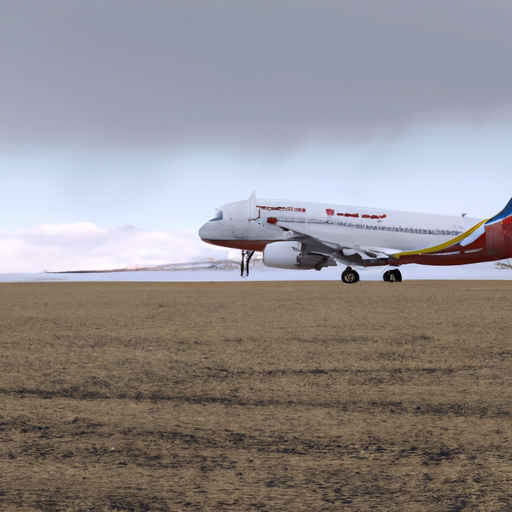
Overview of the Ural Airlines Airbus A320 Emergency Landing Incident in Siberia
On August 15, 2019, a Ural Airlines Airbus A320 made headlines when it was forced to make an emergency landing in a field near Zhukovsky International Airport in Siberia. The incident, which occurred shortly after takeoff, sent shockwaves through the aviation community and left passengers and crew members shaken.
The flight, bound for Simferopol in Crimea, had just taken off when it encountered a flock of seagulls. The birds were sucked into the plane’s engines, causing both engines to fail. With no power, the pilots had to act quickly to find a suitable landing spot. They made the split-second decision to bring the aircraft down in a nearby field, avoiding populated areas and potential disaster.
The emergency landing was nothing short of miraculous. Despite the terrifying ordeal, all 233 passengers and crew members on board survived the incident with only a few minor injuries. The skill and professionalism of the pilots, along with the quick response of emergency services, undoubtedly played a crucial role in the successful outcome of this potentially catastrophic event.
The incident serves as a stark reminder of the importance of bird strike prevention measures in aviation. Bird strikes are a serious concern for airlines worldwide, as they can cause significant damage to aircraft and pose a threat to passenger safety. In response to this incident, aviation authorities have called for increased efforts to mitigate the risk of bird strikes, including improved bird detection systems and stricter regulations around airport wildlife management.
The Ural Airlines Airbus A320 emergency landing also highlights the importance of emergency preparedness and training for both pilots and cabin crew. In this case, the crew’s ability to remain calm under pressure and execute a successful emergency landing undoubtedly saved lives. It serves as a testament to the rigorous training and professionalism of aviation personnel, who are trained to handle a wide range of emergency situations.
The incident also raises questions about the safety of aircraft engines and the need for ongoing maintenance and inspections. While bird strikes are relatively rare, they can have catastrophic consequences if not properly addressed. Airlines and aircraft manufacturers must continue to invest in research and development to improve engine design and bird strike resistance, ensuring the safety of passengers and crew members.
In the aftermath of the emergency landing, Ural Airlines has been praised for its handling of the incident. The airline quickly organized alternative transportation for passengers and provided support and assistance to those affected. The incident serves as a reminder of the importance of effective crisis management and customer care in the aviation industry.
As the investigation into the incident continues, aviation authorities and industry experts will undoubtedly learn valuable lessons that can help prevent similar incidents in the future. The Ural Airlines Airbus A320 emergency landing in Siberia serves as a wake-up call for the aviation community, reminding us of the ever-present risks and challenges of air travel. It is a testament to the resilience and professionalism of those involved and a reminder of the importance of ongoing efforts to improve safety in the skies.
Analyzing the Factors that Led to the Emergency Landing of Ural Airlines Airbus A320

On August 15, 2019, a Ural Airlines Airbus A320 made headlines when it was forced to make an emergency landing in a field near Zhukovsky International Airport in Siberia. The incident, which occurred shortly after takeoff, left the aviation community and passengers alike wondering what could have led to such a dramatic turn of events. In this article, we will analyze the factors that contributed to the emergency landing of the Ural Airlines Airbus A320.
One of the primary factors that led to the emergency landing was the presence of a flock of seagulls in the vicinity of the airport. As the aircraft ascended, it collided with a large number of birds, causing significant damage to both of its engines. This sudden loss of engine power left the pilots with no choice but to initiate an emergency landing. The incident serves as a reminder of the potential dangers posed by bird strikes and the importance of implementing effective measures to prevent them.
Another factor that played a role in the emergency landing was the quick thinking and skillful actions of the flight crew. Despite the chaos and uncertainty caused by the bird strike, the pilots managed to maintain control of the aircraft and execute a successful emergency landing. Their ability to remain calm under pressure and make split-second decisions undoubtedly saved the lives of all 233 passengers and crew members on board. This incident serves as a testament to the importance of pilot training and the critical role they play in ensuring the safety of air travel.
Furthermore, the location of the emergency landing also played a significant role in the outcome of the incident. The fact that the aircraft was able to land in a field, rather than on a densely populated area or in a body of water, greatly reduced the risk of casualties. The relatively flat terrain and absence of obstacles allowed for a smoother landing, minimizing the impact on the aircraft and its occupants. This incident highlights the importance of having suitable emergency landing sites near airports to mitigate the potential consequences of such events.
Additionally, the response of the emergency services and airport personnel played a crucial role in the successful outcome of the incident. The prompt and coordinated efforts of the rescue teams ensured that all passengers and crew members were evacuated safely and provided with the necessary medical attention. The incident serves as a reminder of the importance of effective emergency response protocols and the need for continuous training and preparedness.
In conclusion, the emergency landing of the Ural Airlines Airbus A320 was the result of a combination of factors. The presence of a flock of seagulls, the skillful actions of the flight crew, the location of the emergency landing, and the response of the emergency services all played a role in the outcome of the incident. This incident serves as a reminder of the potential dangers faced in aviation and the importance of implementing effective measures to prevent and mitigate such events. It also highlights the critical role played by pilots, emergency services, and airport personnel in ensuring the safety of air travel.
Examining the Safety Measures and Protocols Followed during the Ural Airlines Airbus A320 Emergency Landing
On August 15, 2019, a Ural Airlines Airbus A320 made headlines when it was forced to make an emergency landing in a field near Zhukovsky International Airport in Siberia. The incident, which occurred shortly after takeoff, left the 226 passengers and crew members on board shaken but thankfully unharmed. In this article, we will examine the safety measures and protocols followed during this emergency landing, highlighting the importance of preparedness and quick thinking in such situations.
When faced with an emergency situation, the crew of the Ural Airlines Airbus A320 demonstrated their professionalism and adherence to safety protocols. As soon as the pilots realized that they were experiencing a dual-engine failure, they immediately declared an emergency and began preparing for an emergency landing. This quick response is a testament to the rigorous training that pilots undergo to handle such scenarios.
One of the first safety measures taken by the crew was to communicate with air traffic control and inform them of the situation. This allowed the airport authorities to clear the runway and ensure that emergency services were on standby. Effective communication is crucial in emergency situations, as it enables all parties involved to coordinate their efforts and respond swiftly.
As the aircraft descended towards the field, the crew ensured that the passengers were prepared for the impact. They instructed everyone to adopt the brace position, which helps minimize the risk of injury during a crash landing. This demonstrates the crew’s commitment to passenger safety and their ability to remain calm under pressure.
Once the aircraft came to a stop in the field, the crew wasted no time in initiating the evacuation process. Passengers were swiftly guided to the emergency exits and instructed to leave the aircraft in an orderly manner. This efficient evacuation procedure is a result of regular training and drills that prepare both the crew and passengers for emergency situations.
Emergency services were quick to respond to the scene, providing medical assistance to those who required it. The fact that there were no fatalities or serious injuries is a testament to the effectiveness of the safety measures and protocols followed during the emergency landing. It also highlights the importance of having well-equipped emergency services readily available at airports.
In the aftermath of the incident, investigators began examining the cause of the dual-engine failure. Preliminary reports suggest that a flock of seagulls flew into the engines shortly after takeoff, causing them to fail. This incident serves as a reminder of the potential hazards that birds can pose to aircraft and the importance of implementing measures to mitigate such risks.
The successful emergency landing of the Ural Airlines Airbus A320 is a testament to the importance of preparedness and adherence to safety protocols. The crew’s quick thinking, effective communication, and efficient evacuation procedures played a crucial role in ensuring the safety of all on board. This incident serves as a reminder of the importance of ongoing training and drills for both crew members and passengers, as well as the need for well-equipped emergency services at airports. By learning from incidents like this, the aviation industry can continue to improve its safety measures and protocols, ensuring that passengers can travel with confidence.


